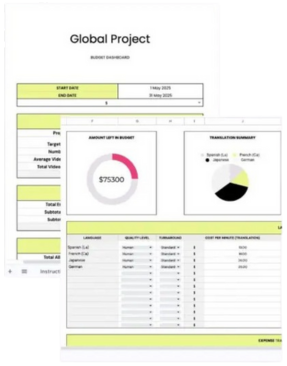The Ultimate Guide to Video Translation

The Age of Inclusive Communication
There are 7,000 languages spoken and an overwhelming majority (90%) favor content presented in their native tongue.
Video translation is no longer a luxury, but a necessity for businesses and creators looking to connect with a wider world.
Video translation allows organizations to adapt their video content for audiences who speak different languages. It goes beyond providing subtitles and dubbing by localizing those assets to the specific regions you are targeting.
By translating your videos, you are able to reach global audiences, enhance user engagement, open up new market opportunities, and create culturally relevant content for local audiences (without recreating your videos from scratch!)
In this guide, we’ll cover everything you need to know about video translation, from understanding the different methods to implementing a successful localization strategy.
Ready to go on a journey together?
What is Video Translation?
Video translation is the process of converting the audio of a video from one language to another, making the video content accessible and localized to a global audience. This includes translating the spoken words and on-screen text of a video.
There are several methods to translate videos:
- Subtitles: provide a textual representation of the original audio, enabling viewers to understand the dialogue while still hearing the original language.
- Dubbing: involves replacing the original audio track of a video with a translated version in a different language, allowing viewers to hear dialogue in their preferred language.
Later, we will explore how to create subtitles and dubbing, and provide guidance on choosing the right method for your video content.
Subtitles vs. Closed Captioning
While the terms “subtitles” and “closed captions” are sometimes used interchangeably in certain regions around the world, there exists a crucial distinction between them, particularly within the framework of accessibility and video content creation best practices.
Here, we will primarily differentiate between these two forms to ensure clarity and promote a comprehensive understanding of their individual functionalities.
Definitions
Captions vs Subtitles
Captions assume the viewer cannot hear. They are time-synchronized text of the audio content and include non-speech elements like noises.
Subtitles assume the viewer can hear but doesn’t understand the language. Subtitles translate the audio into another language and don’t include non-speech elements.
Why Translation is Important
Translating video content is crucial in today’s increasingly virtual and globalized world. At a fraction of the cost—you can reach more viewers in international markets using the same videos you created. With tools like dubbing and subtitling, you can make that experience accessible, immersive and localized to your audience.
The benefits of translation include:
- Enhance Digital Accessibility and Inclusivity: Translation, through subtitles and transcripts, makes video content accessible to a wider global audience, including the significant portion of the population with hearing loss, while also helping organizations avoid legal issues.
- Improve SEO and Global Reach: Catering to non-English speakers unlocks access to vast international audiences, significantly boosting search engine optimization as transcripts provide indexable text data, ultimately increasing content exposure.
- Can Strengthen a Brand’s Connection to: Translating and localizing content demonstrates respect for different cultures and languages, fostering stronger connections with international markets.
What’s the Difference Between Subtitling and Dubbing?
Both subtitling and dubbing are essential components of creating inclusive videos.
Subtitles provide a translated textual representation of the original audio content. They benefit individuals who can’t speak the original language. SDH Subtitles include the non-speech elements and primarily benefit individuals who are deaf or hard of hearing.
Types of Subtitles
- Non-SDH (Regular Subtitles):These are for people who can hear but don’t understand the language being spoken. They only show the words being said.
- SDH (Subtitles for the Deaf and Hard of Hearing: These are for people who cannot hear. They include the words being spoken and other important sound information like music, sound effects, and who is speaking.
- Forced Narrative (FN) Subtitles: These subtitles explain important things you need to understand that aren’t clear from the picture or spoken words. This could be translated on-screen text or unclear dialogue.
Dubbing, on the other hand, involves replacing the original audio track with a translated version spoken in another language. This makes video content accessible to audiences who do not understand the original language. High-quality dubbing requires careful attention to linguistic nuances and synchronization with the on-screen lip movements to create a seamless viewing experience.
Types of Dubbing
- Lip-Sync Dubbing:These are for people who can hear but don’t understand the language being spoken. They only show the words being said.
- Voice-Over Dubbing: The dubbed dialogue is laid over the original audio track. While the original audio might be lowered in volume, it’s often still audible. The focus is less on perfect lip synchronization and more on conveying the meaning of the dialogue. This is often used in documentaries or news reports.
- UN Style Voice-Over: The original speaker’s voice is heard for a short segment, and then the dubbed voice takes over, often during pauses or breaks in the original speech
The choice between subtitling vs dubbing often depends on factors such as the target audience, budget, and desired viewing experience. In many cases, offering both subtitles and dubbing provides the most comprehensive approach to video accessibility and global reach.
How Do You Measure Video Translation Quality?
Unlike captioning, measuring translation quality is a multifaceted process that goes beyond simply checking for grammatical error. In many cases, translation quality can be subjective because you need to evaluate how effectively the translated content conveys the original meaning, intent, and emotional tone to the target audience.
Localization goes beyond mere translation and adapts the content to the cultural context, which might involve adjusting the overall tone.
Key aspects to consider:
- Linguistic accuracy: This involves verifying that the words and phrases used in the translation accurately reflect the source language, without any loss or distortion of meaning, and consider cultural appropriateness.
- Technical execution: For subtitles, this includes factors like synchronization with the audio and video, readability (timing, duration on screen, number of characters per line), and formatting. For dubbing, lip-sync accuracy, naturalness of the voice-over, and appropriate tone of voice are critical.
Ultimately, measuring video translation quality often involves a combination of objective assessments (e.g., error counts, technical checks) and subjective evaluations by native speakers and target audience members to gauge the overall effectiveness and impact of the translated video.
- Linguistic accuracy: This involves verifying that the words and phrases used in the translation accurately reflect the source language, without any loss or distortion of meaning, and consider cultural appropriateness.
- Technical execution: For subtitles, this includes factors like synchronization with the audio and video, readability (timing, duration on screen, number of characters per line), and formatting. For dubbing, lip-sync accuracy, naturalness of the voice-over, and appropriate tone of voice are critical.
Ultimately, measuring video translation quality often involves a combination of objective assessments (e.g., error counts, technical checks) and subjective evaluations by native speakers and target audience members to gauge the overall effectiveness and impact of the translated video.
Cost of Translation
The cost of translation really boils down to the process of creating the translations. Whether you choose humans, machines, or a mix of both – each has its own impact on both cost and quality.
Video translation costs involve several components, including creating the source transcript, the translation itself (human, machine, or hybrid), subtitling/dubbing processes, and quality assurance. Different translation methods (human, machine, or AI-human collaboration) significantly impact both cost and quality.
Pricing models vary (per-word, per-minute, subscription), and factors like video length, turnaround time, and language pair influence the overall expense.
Organizations must decide between building an in-house translation team (higher upfront and ongoing costs for staff and tech) or outsourcing to a vendor (pay-as-you-go model with greater flexibility and access to a wider range of linguists). A hybrid approach is also possible.

Free Resource
Video Translation Budget Planner (Template)
Download the free template to help plan and manage your translation budget
- Outline the project scope
- Track expenses
- Plan your budget
- Evaluate language costs
How To Translate Video
Creating high-quality video translations involves several stages, blending automated and human-driven steps.
Let’s break down how to translate a video:
- Transcription: The foundation of a high-quality translation process is to first create accurate captions in the original video language. This can be created utilizing machine translation, human transcribers, or both.
- Translation: The transcript is translated into the target language(s). Machine translation can expedite this step, but human review and quality assurance is critical to capturing the cultural nuances and complex terminology that AI may struggle with.
- Subtitling: Next, the translation is formatted to industry standards and target platform requirements. Factors such as placement, reading speed, cues, and on-screen text may also be considered to ensure a smooth viewing process.
- Dubbing: a voice actor or AI synthesized speech is utilized to create a localized audio track. Subsequent editing and audio synchronization is performed to ensure a flawless viewing experience.
There are free tools like YouTube Studio, which allow users to automatically translate the original audio, then edit the translations for accuracy, however this can be a very manual process.
Often, high-volume organizations will work with professional video translation services that handle all these steps and ensure a high-quality output. Outsourcing to a vendor can be faster and more cost effective for these organizations.
How to Add Translations to a Video
The process to add subtitles to a video is similar to adding captions. You’ll need a subtitle file (like SRT or VTT) that includes timestamps to synchronize the text with the video.
Dubbing is slightly different because not all video players accept a secondary audio track. A workaround is to upload a separate video featuring the dubbed audio and provide a link for viewers who prefer that version.
What is Human-in-the-Loop Translation?
Human-in-the-loop (HITL) refers to a paradigm where humans and AI work together, leveraging the strengths of both for optimal results, especially where AI alone may fall short.
HITL can be used in both the subtitling and dubbing process. In dubbing, a HITL workflow looks like:
- ASR and Speech Enhancements: AI generates a source script using advancements in Automatic Speech Recognition, speaker recognition, timing detection, and machine translation. Humans then fine-tune this script.
- Synthetic Voice Options: AI offers flexible synthetic native voices, matching, and cloning, allowing for easier adjustments and post-production changes compared to relying solely on voice artists. Humans ensure the speech is flawless, accurately synchronized, and captures the tongue of the target audience.
- Bridging the Gap: HITL addresses the inherent errors in purely automated AI dubbing by incorporating human expertise for quality control.
This hybrid process increases efficiency and reduces cost for organizations.
Is Automatic Translation Good Enough?
Automatic translation software offers a convenient way to provide content in foreign languages. However, like automatic captioning, AI translation often lacks high accuracy and can produce incomprehensible or awkward translations.
Mistranslations can have serious consequences beyond just humorous errors—it can affect comprehension and brand reputation.
The accuracy of automatic translation varies significantly across languages: common languages can have over 90% accuracy, while less common ones can drop below 65%. Therefore, relying solely on automatic translation may not guarantee top-quality translations for all languages, the “human touch” of professional linguists is crucial.
How To Choose the Right Translation Vendor
When choosing a video translation vendor, organizations should evaluate each potential vendor against the following criteria:
- Quality: High-quality translations should accurately capture cultural nuances, have natural line breaks, and be appropriately timed to the media. To assess a vendor’s quality, ask for past translations or request a test file.
- Scalability: For organizations wanting to translate a large volume of video content, how a vendor maintains consistent quality at scale is crucial to understand. Avoid vendors that compromise quality for faster turnaround times. Instead, seek vendors that have a robust system designed to handle large volumes.
- Workflow: Look for an intuitive user experience for uploading and downloading. Bonus points if the vendor can integrate their platform directly into your existing video platform.
- Reliable support: Vendors that are easily reachable and provide clear support documentation will make the translation process that much easier. Consider vendors that offer dedicated account management, particularly for complex workflows.
- Cost-effectiveness: There are many translation solutions that are cheap, but sacrifice quality. Look for vendors who offer affordable solutions and even offer discounts for large volumes of content.
Building Your Business Case for Video Translation
72% of users say subtitles help them understand dialogues, particularly when there is muddled audio or difficult accents. Among younger audiences, subtitles are becoming a necessity.
Dubbing is equally an important part of a video translation strategy. Netflix reported a 120% increase in consumption of programming when dubs were added.
Organizations are now in the beginning of a new globalized era—with video translation at the center. The strategic implementation of robust video translation workflows will undoubtedly define the success and influence of organizations operating on the global stage in this new era.




